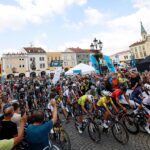
The most famous and difficult bike race, the Tour de France, has changed significantly since its inception in 1903. Technology, science, and planning have changed an endurance test on a bumpy road and poor roads to high-speed spectacles. Recently, the race’s faster pace has become a more heated topic of discussion. We now know that the Tour is getting faster, with average speeds regularly over 41 km/h and even mind-boggling 50 km/h in some stages. The questions are why and how far this trend may go.
What does this acceleration imply for the future of the race? Here’s a closer look at the main factors, which include innovative technology and improved training.
A Hundred Years of Speeding Up
Just over 25 km/h was the average speed of Tour cyclists as they slogged across France at the turn of the twentieth century. A lack of knowledge about nutrition, primitive bikes, and bad roads kept those early editions relatively slow. But as the sport professionalized — with smarter training and advanced gear — average speeds began to rise steadily. This evolution is similar to how online platforms have advanced, where users can now get a $100 casino chip with no deposit in Canada, showing how both sports and gaming continue to reward precision and innovation.
The middle-distance riders today are even faster than what was witnessed in the Tour winners of the past and average speeds that were only witnessed by the winners are now the norm. The race has obviously entered into a new phase, and the speed has never been witnessed before.
Nutrition: The Fuel Behind Performance
Alongside equipment, nutrition science has advanced dramatically. Riders today don’t just eat more — they eat smarter. Each gram of carbs, fat, and protein is determined by looking at the profile of each rider and the needs of the stage. The distance, the terrain, the temperature, and even how much sodium a rider loses every hour are all taken into account in nutrition plans.
The sport has also seen a carbohydrate revolution. Ten years ago, 60 grams of carbs per hour was standard. Now, riders usually eat 120 to 130 grams every hour during races. To aid with this, teams “train the gut” so that riders can consume a lot of carbohydrates without becoming sick. This keeps your energy levels up throughout the race and helps you recover quicker for the future rounds.
Smarter Training Systems
Training used to involve pushing limits until exhaustion. Today, it’s about precision and understanding. Coaches no longer rely solely on increasing fitness metrics like VO2 Max. Instead, they analyze the specific demands of key races and design programs accordingly.
Data collection has also exploded. Every day, things like blood sugar, body temperature, energy levels, and the quality of sleep are measured. This lets training plans be changed quickly to improve success in real time.
Key Reasons Why the Tour Is Getting Faster
Every year, the Tour de France speeds up because of a number of linked causes. These are the most important ones:
- Aerodynamics. Riders are cutting through the air more quickly with narrow wheels, full-body skinsuits, and new helmet designs.
- Lighter, more efficient bikes. Carbon frames, sleek tubing, flat tires, and drivetrains that are better tuned all lower resistance and energy loss.
- High-tech gear. All wearing items, from shoes to spectacles, help you go faster by making you lighter and better at cutting through the air.
- Personalized nutrition. Eating the right amount of carbs has become an exact science, and riders are taking in and using more energy than ever before.
- Scientific training methods. Coaches make plans based on the needs of each race and change them based on detailed bodily input.
- Wider team support. Nutritionists, data scientists, planning tools driven by AI, and cooks all help improve performance.
- Less racing each year. Riders are better prepared for the Grand Tours when they race less during the season.
- Aggressive route design. Organizers now focus on short, sharp stages that make riders want to fight more and take fewer “rest days” on the bike.
As a result, all of these things have an effect that builds on itself, making the total race speed much faster.
Racing Style and Mentality
Being able to physically ride faster isn’t the only thing that matters. It’s also very important how riders approach each stage. Today’s group is more competitive than ever; the pace is high from the first kilometer to the finish line.
More teams are competing with each other, standard “easy” sprint stages are being cut back, and even smaller teams are willing to try to win stages. Breakaways form under immense pressure, and often only after two hours of flat-out racing.
Another transformation lies in the peloton’s hierarchy. With younger riders entering the sport better prepared, the old order of seniority has faded. Everyone is fighting for position, creating more chaotic and faster races.
The Influence of Organizers and Weather
Route design has changed to reflect this new era. The Tour does not have long and flat stages, but shorter and more potent stages to make the race more thrilling. The race still has time trials and mountain stages as major components, but the courses are swapped more frequently.
But you can’t ignore things like the weather that come from outside. Dry weather, tailwinds, and mild temperatures all make stages go faster. Although the Tour organizers cannot control the weather, favorable conditions recently have certainly helped boost average speeds.
Advanced Preparation Standards
Modern riders leave nothing to chance. Today, the process of getting ready is very specific and based on data. Biometric measures are used to make daily changes to training, and food intake is planned down to the gram. As recovery plans improve, team leaders are no longer the only ones who can attend altitude camps; entire groups can now do so.
Below is a second list highlighting the modern tools and practices that define elite-level preparation:
- Real-time tracking of glucose, core temperature, glycogen, and recovery scores.
- Use of smart rings, arm patches, and AI performance platforms.
- Custom training blocks based on specific race stages rather than general fitness.
- High-altitude camps for entire teams, not just select climbers.
- Integration of development riders into pro-level systems from U23 onwards.
- Instead of setting six-week blocks, training should be changed in small ways all the time.
So much planning means that teams can check every little thing for small changes that, when added up, make a big difference on the road.
What Lies Ahead?
The Tour de France route in 2025 is a little shorter and goes up and down less than in earlier years. This could be the start of another record-breaking year. With another season of new technologies and a strong new group of riders, there are good chances that speeds will go up.
Looking into the future, it is evident that we are not anywhere near the ceiling. However, with improved food, training, and equipment, the Tour de France is entering into a new era of velocity, and it does not seem to slow down anytime soon. Safety concerns and ethical issues, such as cheating, are still of concern.
The post Why the Tour de France Keeps Getting Faster and Won’t Slow Down appeared first on PezCycling News.




